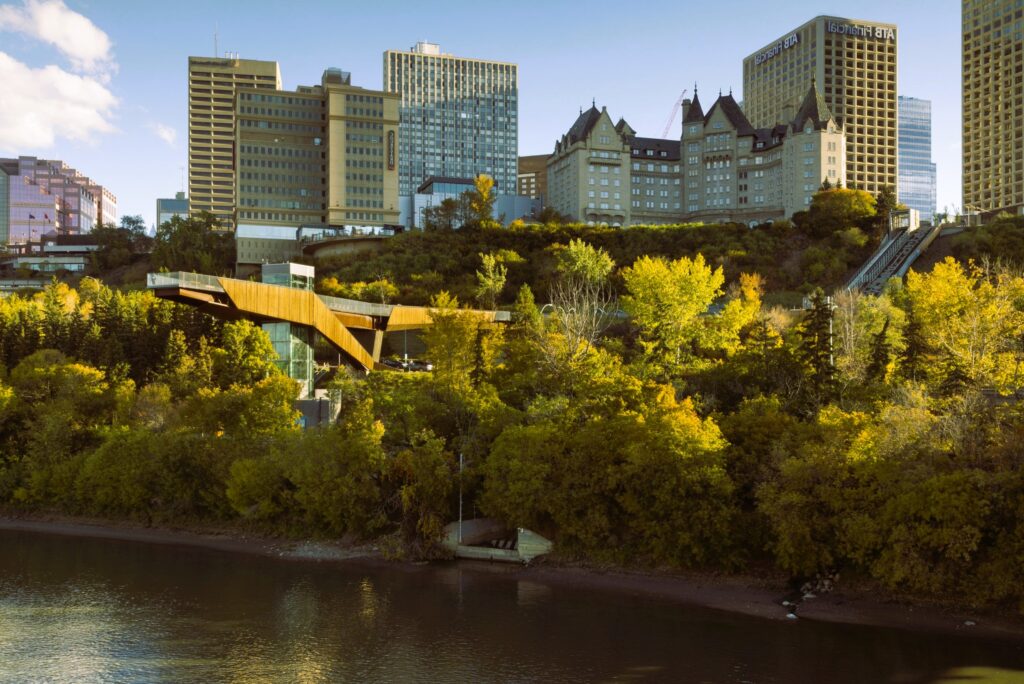Edmonton, nestled along the picturesque North Saskatchewan River, boasts one of the most expansive and breathtaking urban park systems in North America—the Edmonton River Valley. This lush and diverse landscape, stretching over 7,400 hectares, not only serves as a haven for outdoor enthusiasts but also provides a natural canvas for landscape architects to weave their creative designs. In this exploration, we delve into the symbiotic relationship between the Edmonton River Valley and landscape architecture, showcasing how this natural masterpiece has inspired innovative designs that enhance the city’s connection with nature.
- Preserving Natural Beauty: The Edmonton River Valley, with its rolling hills, winding trails, and vibrant greenery, is a testament to the city’s commitment to preserving its natural beauty. Landscape architects play a pivotal role in ensuring that the development and enhancement of the River Valley prioritize conservation. Designs often focus on preserving native flora and fauna, minimizing ecological impact, and promoting sustainable practices to maintain the area’s biodiversity.
- Strategic Trail Networks: Landscape architects have strategically designed trail networks that meander through the River Valley, providing residents and visitors with an immersive experience in nature. The trails, carefully integrated into the landscape, cater to a variety of activities, including hiking, biking, and jogging. The Capilano Bridge and Trail system, for example, showcases how thoughtful design enhances accessibility while minimizing environmental disruption.
- Riverbank Stabilization and Erosion Control: The North Saskatchewan River, with its dynamic flow, poses challenges such as erosion along the riverbanks. Landscape architects employ innovative techniques for riverbank stabilization, utilizing native vegetation, retaining walls, and erosion control measures. These designs not only protect the River Valley’s delicate ecosystems but also enhance the resilience of the area against natural forces.
- Iconic Bridges as Architectural Features: Edmonton’s River Valley is adorned with iconic bridges that serve as both functional crossings and architectural features. The Walterdale Bridge, with its contemporary design and illuminated arches, stands as an example of how landscape architects collaborate with structural engineers to create visually striking and functional elements. These bridges not only connect different parts of the River Valley but also contribute to the aesthetic appeal of the landscape. Read about how innovation shapes the horizon in our article.
- Terraced Gardens and Outdoor Spaces: Landscape architects leverage the topography of the River Valley to create terraced gardens and outdoor spaces that provide panoramic views of the surroundings. These well-planned areas, such as the Muttart Conservatory and its surrounding gardens, showcase the integration of architecture with the natural landscape. They serve as inviting spaces for relaxation, recreation, and community engagement.

- Natural Amphitheaters for Community Events: The River Valley’s expansive green spaces provide a natural setting for community events and gatherings. Landscape architects design natural amphitheaters and event spaces that harmonize with the surroundings, offering venues for concerts, festivals, and cultural events. Hawrelak Park, with its amphitheater overlooking the water, exemplifies how thoughtful design can enhance the cultural vibrancy of the city.
- Year-Round Activation: Landscape architects consider the seasonal changes in Edmonton, ensuring that the River Valley remains a vibrant and active space throughout the year. Designs incorporate features such as winter-friendly amenities, including skating rinks and cross-country skiing trails. This commitment to year-round activation reflects the adaptability of landscape architecture in meeting the diverse needs of the community.
Conclusion:
The Edmonton River Valley stands as an awe-inspiring testament to the harmonious collaboration between nature and landscape architecture. Through thoughtful design and preservation efforts, landscape architects have transformed this expansive green oasis into a dynamic and multifunctional space. As Edmonton continues to evolve, the River Valley remains a living canvas for creative designs that celebrate the city’s natural heritage.
For further exploration of the Edmonton River Valley and the interplay between nature and design, refer to reputable sources such as Wikipedia. These platforms provide comprehensive insights into the history, ecology, and ongoing developments within the Edmonton River Valley.
